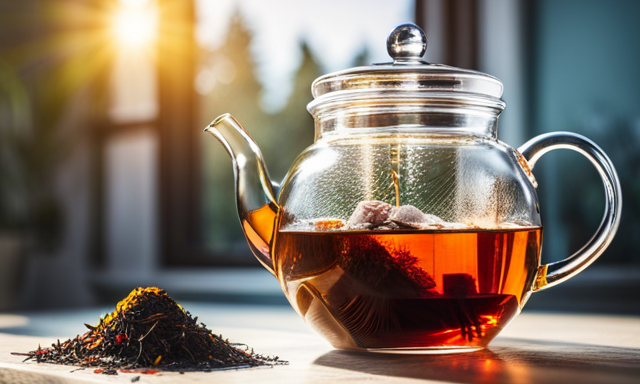When it comes to choosing a healthy tea option, the debate between green rooibos and red rooibos has been brewing. Both variants of rooibos tea offer a range of health benefits, but which one is truly superior? In this article, I will delve into the nutritional and health properties of green rooibos and red rooibos, allowing you to make an informed decision based on evidence.
Green rooibos, often referred to as the ‘younger sibling’ of red rooibos, is harvested from the same South African plant but undergoes minimal oxidation during processing. This means that green rooibos retains more of its natural antioxidants, making it a potential powerhouse for boosting your overall health.
On the other hand, red rooibos, the more popular and widely consumed variant, offers its own unique set of health benefits. As we explore the antioxidant and caffeine content, as well as the digestive and skin health benefits of both teas, you’ll be equipped with the knowledge to choose the right option for your health goals.
So, let’s dive in and discover which rooibos tea reigns supreme!
Key Takeaways
- Green rooibos has higher antioxidant levels compared to red rooibos.
- Red rooibos has higher mineral levels compared to green rooibos.
- Both green and red rooibos have various health benefits, including immune-boosting properties, digestive health benefits, and skin health benefits.
- When choosing between green and red rooibos, consider your health goals and preferences, such as antioxidant content, nutrient profile, and caffeine content.
Brief Overview of Rooibos Tea
Rooibos tea, also known as red bush tea, is a herbal tea that comes from the leaves of the Aspalathus linearis plant, which is native to South Africa. It has been consumed for centuries due to its various health benefits.
Rooibos tea is rich in antioxidants, such as aspalathin and nothofagin, which can help protect the body against free radicals and reduce inflammation. It is also caffeine-free, making it a great alternative to traditional teas.
Additionally, rooibos tea has been found to support digestion, improve heart health, and boost the immune system.
Now, let’s dive into the topic of green rooibos and explore its unique characteristics.
What is Green Rooibos?
Green Rooibos is a type of tea that is made from the leaves of the Aspalathus linearis plant. It is produced and processed in a similar way to red rooibos, but the leaves are harvested earlier, while they are still green.
Green rooibos is known for its high antioxidant content and is believed to have numerous health benefits. These benefits include improved digestion, increased immune function, and reduced inflammation.
Production and Processing Methods
Through careful processing and nurturing, red rooibos takes on a rich, earthy flavor that transports you to the sun-drenched fields of South Africa.
The production methods for red rooibos involve harvesting the leaves of the Aspalathus linearis plant, then bruising and fermenting them to enhance the flavor and color. After fermentation, the leaves are dried in the sun, resulting in the deep red hue that gives red rooibos its name.
These production methods contribute to the unique taste and aroma of red rooibos.
In terms of health benefits, red rooibos is known for its high antioxidant content, which promotes overall well-being and may help protect against chronic diseases.
Moving on to the next section about the nutritional profile and health benefits of red rooibos, it is important to highlight its remarkable properties.
Nutritional Profile and Health Benefits
Experience the amazing health benefits of red rooibos with its rich nutritional profile that can support your overall well-being and contribute to a healthier lifestyle.
Red rooibos is packed with antioxidants, such as aspalathin and nothofagin, which can help reduce oxidative stress and lower the risk of chronic diseases like heart disease and cancer. These antioxidants also have anti-inflammatory properties, which can support a healthy immune system and reduce the risk of inflammatory conditions.
Red rooibos is also naturally caffeine-free, making it a great alternative to other caffeinated beverages. It is rich in minerals such as calcium, magnesium, and potassium, which are essential for maintaining strong bones, regulating blood pressure, and supporting overall bodily functions.
With its impressive nutritional profile, red rooibos is a fantastic addition to a balanced diet. Transitioning into the subsequent section about ‘what is red rooibos?’, this incredible tea offers not only health benefits but also a unique flavor profile that makes it a popular choice among tea enthusiasts.
What is Red Rooibos?
Red Rooibos is a type of herbal tea made from the leaves of the Aspalathus linearis plant. It has a vibrant red color and an earthy flavor. The production and processing methods of Red Rooibos involve fermenting the leaves, which enhances its flavor and aroma.
Red Rooibos is rich in antioxidants, vitamins, and minerals, making it a healthy beverage choice. It is believed to have numerous health benefits, including promoting heart health, boosting the immune system, and aiding in digestion.
Production and Processing Methods
The production and processing methods of green rooibos make it a healthier choice than red rooibos. Green rooibos is made from the leaves of the Aspalathus linearis plant, which are carefully harvested and immediately dried to prevent oxidation. This minimal processing retains more of the plant’s natural nutrients and antioxidants.
-
Less oxidation: Green rooibos is not oxidized like red rooibos, which means it retains a higher amount of polyphenols, flavonoids, and other beneficial compounds.
-
Higher antioxidant content: The minimal processing of green rooibos helps preserve its antioxidants, which can help fight inflammation and protect against chronic diseases.
-
Greater nutrient retention: The production methods of green rooibos ensure that it retains higher levels of essential minerals like iron, zinc, potassium, and magnesium.
Moving on to the next section about the nutritional profile and health benefits of green rooibos, it is important to understand its impact on overall well-being.
Nutritional Profile and Health Benefits
Indulging in the vibrant flavors of this antioxidant-rich tea is like sipping on a cup of sunshine that nourishes your body from within.
Green and red rooibos both offer impressive nutritional benefits. They are both caffeine-free, making them a great alternative to black tea.
Green rooibos, in particular, is known for its higher antioxidant content compared to red rooibos. Antioxidants help protect our cells from damage caused by harmful free radicals.
Additionally, green rooibos contains higher amounts of vitamins and minerals compared to red rooibos. It is rich in vitamin C, which is essential for immune function and skin health. Green rooibos also provides minerals like calcium, magnesium, and zinc. These nutrients contribute to overall health and well-being.
Moving on to the next section about antioxidant content comparison, let’s explore how green and red rooibos stack up against each other in this aspect.
Antioxidant Content Comparison
Boost your health by exploring the antioxidant content comparison between green rooibos and red rooibos.
Antioxidants are compounds that help protect the body against damage from harmful free radicals. Both green and red rooibos are rich in antioxidants, but they differ in their specific types and quantities.
Green rooibos contains higher levels of aspalathin and nothofagin, two unique antioxidants that have been shown to have various health benefits. These antioxidants have been linked to reducing inflammation, improving heart health, and supporting the immune system.
On the other hand, red rooibos contains a higher concentration of other antioxidants like quercetin and luteolin, which are known for their anti-inflammatory and anti-cancer properties.
Both types of rooibos have significant antioxidant benefits that can have positive health implications.
Moving on to the next section, let’s compare the caffeine content between green and red rooibos.
Caffeine Content Comparison
If you’re looking to reduce your caffeine intake, you’ll be pleased to know that green and red rooibos offer a caffeine-free alternative. Both varieties of rooibos tea are naturally caffeine-free, making them a great choice for those who are sensitive to caffeine or trying to cut back on their consumption.
Here are some key points about the caffeine content and health effects of green and red rooibos:
-
Caffeine content: Green and red rooibos contain zero caffeine, which means they won’t interfere with your sleep or cause jitters.
-
Health effects: Rooibos tea is rich in antioxidants, which help to protect the body against damage from harmful free radicals. It is also known for its anti-inflammatory properties and potential benefits for heart health.
Transition: As we move into the next section, let’s explore the immune-boosting properties of rooibos tea.
Immune-Boosting Properties
With its rich antioxidant content, both green and red rooibos tea can help strengthen your immune system and ward off illness.
Rooibos tea contains various compounds, such as polyphenols and flavonoids, which have been shown to have immune-boosting properties. These compounds help to neutralize harmful free radicals in the body, reducing oxidative stress and promoting overall wellness.
Additionally, rooibos tea is a good source of vitamins and minerals, including vitamin C, which is known to support immune function. Regular consumption of rooibos tea can help optimize your immune system and enhance your body’s ability to fight off infections and diseases.
Moving on to digestive health benefits, rooibos tea has been found to have soothing properties that can help alleviate digestive discomfort and promote a healthy gut.
Digestive Health Benefits
Improve your digestive health and experience the soothing power of rooibos tea as it works wonders for your gut, leaving you feeling like a brand new person. Here are three digestive health benefits of rooibos tea:
-
Relieves digestive discomfort: Rooibos tea contains anti-inflammatory properties that can help alleviate symptoms of digestive disorders like irritable bowel syndrome (IBS) and indigestion. It can soothe the lining of the digestive tract and reduce inflammation, providing relief from discomfort.
-
Promotes healthy digestion: The natural compounds found in rooibos tea, such as polyphenols and flavonoids, have been shown to support the growth of beneficial gut bacteria. These bacteria play a crucial role in digestion, helping to break down food and absorb nutrients more efficiently.
-
Reduces gastrointestinal spasms: Rooibos tea has been found to have antispasmodic properties, which can help ease gastrointestinal spasms and cramping. It can provide relief from conditions like bloating and constipation, promoting a healthier gut.
Transitioning into the subsequent section about ‘skin health benefits’, rooibos tea not only improves digestive health but also offers numerous benefits for your skin.
Skin Health Benefits
Indulge in the rejuvenating effects of rooibos tea as it works wonders for your skin, leaving you with a radiant and youthful glow. Rooibos tea, whether it’s green or red, offers numerous skin health benefits due to its rich antioxidant properties. These antioxidants help protect your skin from harmful free radicals, preventing premature aging and reducing the appearance of wrinkles. Additionally, rooibos tea contains alpha hydroxy acid, which promotes skin cell renewal and improves skin texture. To visualize the skin benefits of rooibos tea, take a look at the table below:
| Skin Health Benefits of Rooibos Tea |
|---|
| Reduces inflammation |
| Soothes irritated skin |
| Enhances skin elasticity |
| Improves skin tone |
| Hydrates and moisturizes skin |
By incorporating rooibos tea into your daily routine, you can enjoy these antioxidant benefits and experience the anti-aging effects it has on your skin. Now, let’s move on to the next section to explore the flavor and taste comparison between green and red rooibos teas.
Flavor and Taste Comparison
When it comes to comparing the flavor and taste of green rooibos and red rooibos, personal preferences play a significant role.
Green rooibos has a mild, grassy flavor with subtle hints of honey and vanilla, making it a refreshing and delicate choice.
On the other hand, red rooibos has a richer, earthy taste with notes of caramel and woodiness, providing a robust and full-bodied experience.
Both types can be enjoyed hot or iced, and the brewing techniques are quite similar. Simply steep the rooibos in boiling water for about 5-7 minutes, and you’ll have a delicious cup of tea ready to savor.
Now that we’ve explored the flavors of these two rooibos varieties, let’s move on to making the right choice for your health goals.
Making the Right Choice for Your Health Goals
To make the right choice for your health goals, it’s crucial to consider the unique benefits and characteristics of each variety of rooibos tea. Green rooibos and red rooibos offer different health benefits, so understanding these distinctions can help you make informed choices.
Here are three key factors to consider when deciding between green and red rooibos:
-
Antioxidant content: Green rooibos undergoes minimal processing, which preserves higher levels of antioxidants compared to red rooibos. These antioxidants can help protect cells from damage caused by harmful free radicals.
-
Nutrient profile: Red rooibos contains higher levels of certain minerals like calcium, magnesium, and potassium. These minerals are essential for maintaining healthy bones, muscles, and overall bodily functions.
-
Caffeine content: Green rooibos is naturally caffeine-free, making it a suitable choice for those who want to limit their caffeine intake. Red rooibos, on the other hand, contains no caffeine but may have a calming effect due to its high levels of the antioxidant aspalathin.
By understanding the health benefits of green and red rooibos, you can make an informed choice that aligns with your specific health goals.
Frequently Asked Questions
Are there any side effects associated with consuming green or red rooibos tea?
I haven’t found any evidence of significant side effects associated with consuming rooibos tea. On the contrary, it is known for its numerous health benefits, including its antioxidant properties and potential anti-inflammatory effects.
Can green or red rooibos tea help with weight loss?
Looking to shed some pounds? Green and red rooibos tea offer numerous benefits. Green rooibos tea boosts metabolism and aids in weight loss, while red rooibos tea reduces fat storage and promotes a healthy digestion.
Can green or red rooibos tea be consumed during pregnancy?
Green and red rooibos tea can be consumed during pregnancy. Both teas have their own benefits, such as aiding digestion and boosting the immune system. However, it is important to consult with a healthcare professional for personalized advice.
Are there any differences in the brewing methods for green and red rooibos tea?
There are differences in taste and brewing time between green and red rooibos tea. Green rooibos has a lighter, grassier flavor and requires a shorter brewing time than red rooibos, which has a richer taste.
Can green or red rooibos tea interact with any medications?
Green and red rooibos teas may interact with certain medications. It is important to consult with a healthcare professional to determine if there are any potential interactions between these teas and your specific medications.
Conclusion
In conclusion, both green and red rooibos teas offer numerous health benefits. Green rooibos has a slightly higher antioxidant content and may be beneficial for digestive health. On the other hand, red rooibos is rich in antioxidants and can promote skin health. Some may argue that the taste of green rooibos is not as pleasant as red rooibos. However, considering the wide range of health benefits, it is worth giving both varieties a try. Ultimately, the choice between green and red rooibos depends on individual preferences and health goals.










